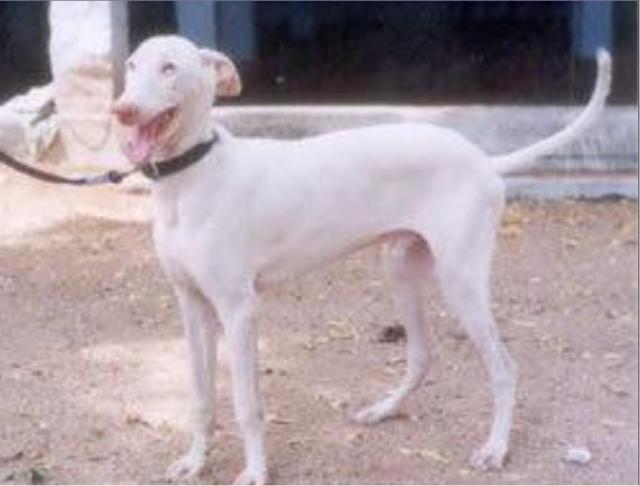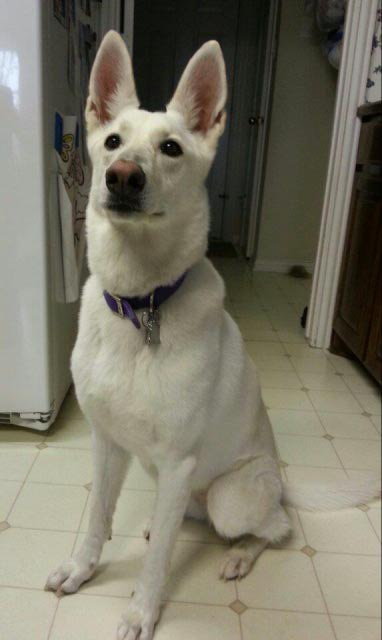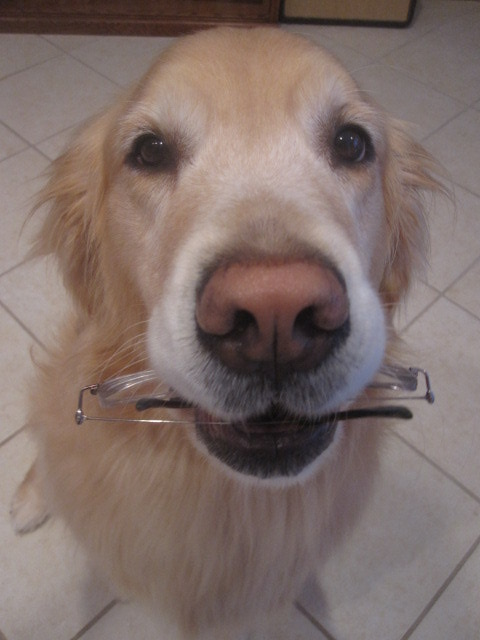QuestionI rescued this 2 1/2 yr old mix lhasa-shitsu am having a terrible time with his going in the house. I can let him out he can do both things and if he gets to go up stairs he thinks that's his barnyard and he'll go again.I just had the carpets cleaned a I was shown with an uv light all the places he had gone.My carpet is a tweed and it''s awful hard to see pee some times.any suggestions on this problem?
2nd problem he doesn't like men except me and that's taken about 4 months for him to get to know me-that's how long we've had him--sometimes he goes nuts when a male comes into the house. He has even nipped at them lately. He also barks terribly when the door bell rings Iv'e started spraying with water and this has done some good. He is really a good dog and we are completely attached to him but I just want things to be better--I have a lung probllem (20%)and torn rotater cuffs so it's hard for me to handle an unrully dog but I will live with it if I have to.
Thank you for any help you can give me it's greatly appreciated--I am also thinking about getting a dog training kit but I really don't have $90.00 to invest with out knowing if it will really work-- thanks again--Don
AnswerGreetings, and thank you for contacting All Experts!
First of all, I want to thank you wholeheartedly for rescuing, I think it is great you opened your heart and home to this boy! Shelter dogs or dogs that come from rescues often come with a ''baggage'', but many if helped in the right way and with a little TLC, after a bit of time, turn out to make great companions that bond greatly with their owners. Many dogs take just a few weeks to adjust, others may take several months, some such as abused or neglected dogs times, years. I will try to tackle your issues one at a time.
1st Problem: Urination
The fact you are using a UV light is great, these are very helpful in identifying urinated areas, however it is also important to use the right products. You can clean all day, but if you are using the wrong products to clean, traces will still linger no matter what. I am assuming however, that you are already familiar with products that ''neutralize odors'' and that therefore contain ''odor eating''enzymes since, many of them come in a kit with a UV light.
It sounds like from your description he is using your upstairs floor as a bathroom. If he is urinating outdoors most of the time, and therefore his bladder is quite empty, what you are seeing is likely marking. You do not claim if your boy is neutered or not, however, even neutered males and females tend to urine mark. However, at times, dogs also get urinary tract infections or other urinary problems which can cause the behavior you are seeing, however, in the case of a urinary tract infection, you would more likely see him urinating a little dribble of urine just about anywhere.
Assuming this is not caused by an urinary infection (which should always be ruled out when dogs appear to soil in the home)and that he is only doing this upstairs to mark, there are several things you can do. One of them is management. Management means simply to deal with the problem by attempting to reach a goal even though not directly. In other words, you will save yourself and your dog a whole lot of time and energy if you would simply install a baby gate or a barrier to prevent him going upstairs. Dogs do not have to have the full reign of the the house, a few off limit areas will make life much easier.
Another management option if he is sneaky and tends to urinate out of your sight, is to put him on an umbilical cord, in other words, you attach the leash to his collar and connect the leash to your belt. This way he is always under your control and if you see him ready to lift his leg you can clap your hands to startle him slightly, giving you time to take him outdoors if need be. And of course, the most recommended management tool is the crate, crates can be man's best friend when used as a management tool. Use it when you cannot supervise your dog or when you leave the house. Of course, if you decide to go this route, make sure you introduce it properly and gradually. Here is a guide on introducing rescued dogs to a crate:
http://adrienne-farricelli.suite101.com/how-to-make-your-dog-love-its-crate-a380
Management, therefore is your best option, since it sounds like he mostly marks upstairs when you are not around. Unfortunately, once the behavior has established itself, it will continue if no measures are taken. And while cleaning may sound like you are on the right track, it may actually, make him urinate more if he is marking. Indeed adding a fresh ''layer'' on previously marked area is common in dogs. Ever seen, how intent dogs are to mark area again outdoors after it rains?
2nd Problem: Fear of Men/Door bell barking
Often owners of rescued dogs assume dogs are scared of men because they possibly were abused by men, however, this cliche' doesn't always hold true. There are dogs with a perfect history of being raised in loving families that are still scared of men. So what gives? There can be several explanations. One plausible explanation is that the dog may have not been socialized with different types of men much, especially from puppy hood, during that critical time between 4 and 16 weeks. Another explanation may stem from the fact that men from some dog's point of view, may appear to be more intimidating.
Men are often taller respect to women, they may have much deeper voices and have facial hair, and what many of may of us may not realize is, that men also often move in a more assertive fashion. Applied animal behaviorist Patricia McConnell also mentioned studies were done where men were found to be seen as ''coming closer at higher rates or stronger intensity'' respect to women. Also consider that coming in and out of doors is one of the biggest triggers for many reactive dogs and this is one of the areas that needs managed the most. You can read more about these studies here:
http://www.theotherendoftheleash.com/why-dog-are-more-afraid-of-men
I will offer a behavior modification program that may help your dog cope better with men entering your home. In order to accomplish this, you will of course, need some men to come over and help volunteer. You will also have to equip yourself with a nice treat pouch you can clip to your belt (to be practical) a leash, and the tastiest treats out there. These are not your regular kibble or those stale dog biscuits forgotten a month ago in a jar. You want to invest in in freeze dried liver, slivers of hot dog, small chunks of steak or grilled chicken. You need them in very bite size pieces (and if you give a lot of them or do this often, you will need to adjust your dog's feeding ratio).
You can do this exercise from a sitting position (by the way, I am sorry to hear you are suffering from several health ailments) with your dog leashed to you. Make sure please, please, please that he cannot get free. Nipping can be quite reinforcing, in other words, once a dog realizes that by nipping a guest, the guest leaves or moves away, the dog feels like repeating the action. And also you want to keep your guests safe. Warning: you may initially see the behavior becoming worse than better at times, but this is a good sign, that the training is working.
Step 1: Do this exercise a few days ahead before engaging the male volunteers. Basically, make a smacking noise with your mouth and immediately after, drop a treat or give it with your hand. You want to repeat, repeat, repeat, until he starts to associate the noise with treats. You know this has happened when upon making the noise your dog looks at you for the treat. At this point, congratulations! you have classically conditioned your dog! This is Pavlov's law, if you want to read more about classical conditioning and Pavlov's dogs here is an interesting read:
http://adrienne-farricelli.suite101.com/the-use-of-classical-conditioning-in-dog
Step 2: Have somebody practice on ringing the door bell. You will stay seated in your chair with your dog at a distance of several feet away. You want to initially work from under the threshold, this means from a distance where he is a bit less likely to react. The moment he hears the door bell immediately make the smacking noise with your mouth and deliver a treat. Repeat, repeat, repeat until you classical condition your dog to love that sound. You know that happens when upon hearing the door bell your dog looks at you anticipating the treat. You are basically, changing your dog's emotional state about the door bell. Dogs live through associations,indeed many live on these equations: can opener= food, leash=walk, doorbell=guests, and so forth. What we are trying to accomplish here is to associate doorbell and men with treats and good things happening.
Note; if your dog is still barking at the door bell and does not accept treats, you are working too closely and he is too aroused, try to work from the farthest room of the house initially.
Step 3: Have a volunteer ring the door bell. Proceed as usual giving the treat upon hearing the ring. Now, have the volunteer open the door a little bit. Before your dog goes in a barking frenzy try to toss two-three treats on the floor. Have the volunteer stand there until the dog eats all the treats. Then have the volunteer leave. What we are trying to accomplish is to make the dog learn this equation: ''when the male guest appears I get treats, when he disappears the treats are gone''.
Step 4: Continue the exercise but have the volunteer gradually open the door more and more. Repeat giving 2-3 treats the moment the door opens and then have it closed when the dog is done eating. At one point, have the door completely open with the man there not looking at your dog with his head turned sideways not making eye contact, and not talking. At this point, give 4-5 bite sized treats and have the man close the door and leave when he is done. Repeat this sequence of opening the whole door and closing it. Be good in your timing! And never have the man leave if your dog barks. If he barks, get his attention back on you by making the smacking noise with your mouth and giving treats for stopping.
Note: if at some point your dog is getting increasingly nervous, step back a bit in the program and go back to having your guest just opening the door a bit. Every time, you note your dog has a set back, go back a few steps in training.
Step 5: Have your guest now open the door and hopefully your dog by now has learned to look for treats and have him take one step into home. Continue giving 4-5 treats and once the dog is done, have the man step back and close the door. Yes, you got it: your objective is to continue until your guest can walk inside your home without your dog going into a frenzy. At some point, you want your guest to take over and be the one to toss the treats upon opening the door and stepping in. The more the person comes close the more high value and more treats are delivered.
If you can, actually invest in a Kong, stuff it up and have your guest toss it towards your dog. Repeat, repeat, repeat. If you want to be extra successful, you can also set up your volunteers with meal time. Have them come over when your dog needs fed and have them open the door, come in and place the food bowl down, watch him eat from a distance and then toss a nice treat before leaving. All good things start when the guest is over, and all good things end when the guest leaves.
One thing about dogs is that they do not generalize well. Therefore if your dog learns to accept males as guests, he may not accept males on walks. You therefore may have to make the smacking sound with your mouth every time a man is walking nearby and then have some men on walks volunteer in tossing treats.
May I recommend a great read? ''Cautious Canine'' by Patricia McConnell, which gives details about a similar approach. See, you may no longer need to invest your money in that training kit
anymore, just invest in a few tasty treats, a barrier to prevent your dog from going upstairs, and you are all set! Sorry this turned out lengthy, and I hope you are not overwhelmed! Hope this helped, best wishes and kind regards,
Adrienne Farricelli CPDT-KA
Disclaimer: if your dog is exhibiting behavioral problems please consult with a veterinarian specializing in behavioral problems or a dog behaviorist. By reading this answer you accept this disclaimer and fully assume responsibility for any of your actions.

 breed identification
QuestionMaggie
QUESTION: Hello - Ive hopped over
breed identification
QuestionMaggie
QUESTION: Hello - Ive hopped over
 Rajapalayam dogs
Question
Rajapalayam dogs
good morning madam. are rajap
Rajapalayam dogs
Question
Rajapalayam dogs
good morning madam. are rajap
 White German Shepherd Aggression
Question
Chloe
A little background on my dog Chl
White German Shepherd Aggression
Question
Chloe
A little background on my dog Chl
 question about beagle puppy
QuestionHello, I have recently acquired a beagle puppy.
question about beagle puppy
QuestionHello, I have recently acquired a beagle puppy.
 Crystal the beagle
Question
Crystal
Crystal is 8 1/2 years old,she is a be
Crystal the beagle
Question
Crystal
Crystal is 8 1/2 years old,she is a be